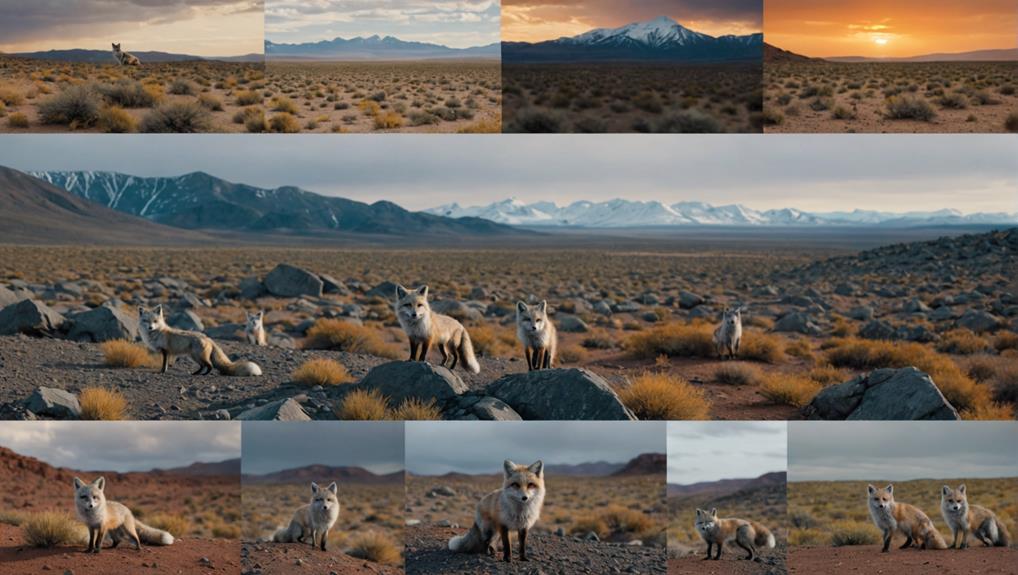Foxes, those clever little creatures, live in all sorts of habitats around the world! From urban areas where they scavenge rummage through bins to rural landscapes rich with forests and grasslands, they adapt like pros. Red foxes roam widely across continents, while elusive Arctic foxes thrive in icy climates. They're not picky; foxes choose dens based on safety and food availability. Urban foxes often cozy up in gardens, while their country cousins dig natural burrows. Sadly, they face challenges from climate change and human encroachment. Stick around, and you'll discover more about their fascinating lives and the efforts to keep them thriving!
Contents
- 1 Overview of Fox Species
- 2 Habitat Diversity Across Continents
- 3 Geographic Distribution of Foxes
- 4 Adaptation Strategies in Various Environments
- 5 Conservation Status of Fox Populations
- 6 Role of Foxes in Ecosystems
- 7 Human Impact on Fox Habitats
- 8 Climate Influence on Fox Distribution
- 9 Urban Vs. Rural Fox Habitats
- 10 Future of Fox Conservation Efforts
- 11 Final Thoughts
Overview of Fox Species
When you explore the world of fox species, you'll find a fascinating array of animals that exhibit remarkable adaptability and diversity.
Take the red fox, for example. With its striking reddish-orange fur, it's the largest true fox species and has made itself at home in both rural areas and bustling urban environments. The red fox thrives in a variety of habitats, including forests, grasslands, and even deserts, showcasing its incredible versatility in adapting to different environments.
You'll see red fox populations thrive in places you mightn't expect, like city parks and backyards, proving they can adapt their habitat preferences to suit their needs.
But it doesn't stop there! The gray fox, for instance, has a unique twist: it can climb trees. This ability sets it apart from its kin and highlights the variety among fox species.
Each type of fox plays a significant role in its ecosystem and interacts with native species in surprising ways, contributing to ecological balance by regulating populations of small mammals and birds this fascinating adaptability.
Habitat Diversity Across Continents
Foxes' remarkable adaptability is evident in the diverse habitats they occupy across continents.
Take red foxes (Vulpes vulpes), for example; they thrive in everything from bustling urban areas to serene rural landscapes. In cities, these clever creatures often find cozy dens in gardens or under sheds, showing just how well they can adjust to human life.
Meanwhile, out in the countryside, red foxes prefer forests, grasslands, and farmland, where they hunt small mammals like rodents and rabbits. Their presence in mixed landscapes highlights their ability to thrive in varying environments.
What's fascinating is how different regions create unique populations of foxes. For instance, while the Arctic fox (Vulpes lagopus) loves the icy cold, American red foxes (Vulpes vulpes fulvus) are mastering the many terrains of North America.
Their habitat choices depend on various factors, including soil types, vegetation, and even how many humans are around.
Geographic Distribution of Foxes
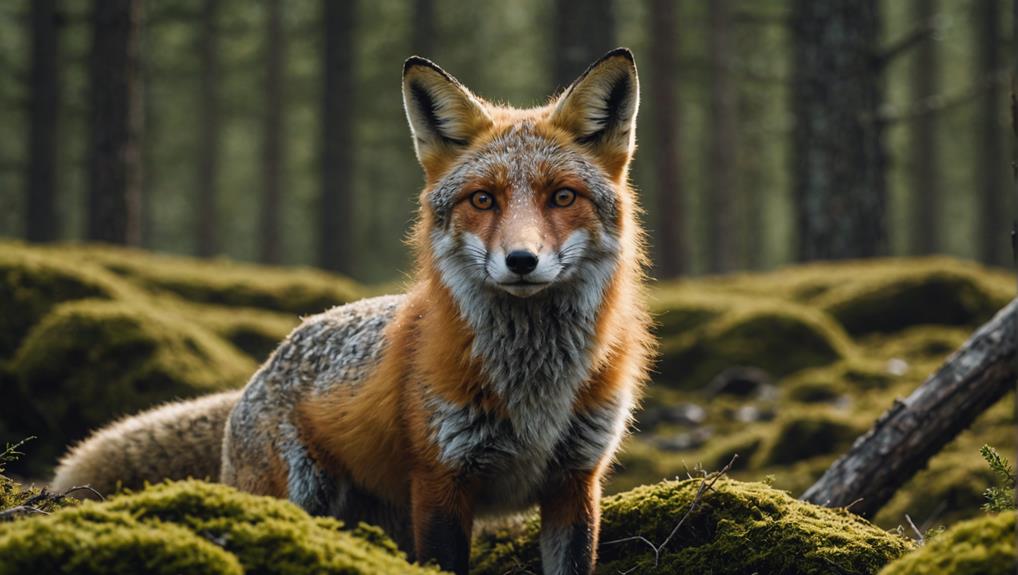
When you think about foxes, it's fascinating to realize they roam across so many parts of the world! From the forests of North America to the urban jungles of Europe, these clever critters have adapted to all sorts of habitats.
Their adaptability extends even to extreme environments, such as the Arctic, where the Arctic fox employs impressive key adaptations for survival to thrive in harsh conditions.
But as climate changes, they're even inching into the Arctic, which could stir up some serious competition with their native neighbors.
Global Range Overview
With a range spanning approximately 70 million square kilometers, the red fox (Vulpes vulpes) boasts the widest distribution of any wild canid. You can find these clever creatures in various habitats across North America, Europe, Asia, and parts of North Africa. In North America alone, red fox populations include both native subspecies and those non-native European red foxes introduced in the 1700s. They've made quite an impact on local ecosystems!
What's truly fascinating is how adaptable the red fox is. Urban red foxes have become the masters of city life, often seen darting through streets and parks. While they may prefer their rural cousins' natural habitats like forests and grasslands, these city slickers show us just how well they can thrive in human-altered landscapes.
As red foxes expand into Arctic regions, thanks to climate change, it raises some eyebrows. Increased competition with native species, like the Arctic fox, could lead to significant changes.
Understanding the global range of the red fox not only helps us appreciate their resilience but also highlights the importance of safeguarding diverse species populations for future generations.
Habitat Variability Factors
Habitat variability plays an essential role in the geographic distribution of red foxes (Vulpes vulpes). You might be surprised to learn that these clever creatures thrive in a wide range of environments, from bustling cities to quiet forests. Their ability to adapt is impressive!
Here are some key factors that influence their habitats:
- Den Sites: Foxes prefer dens in loose, well-drained soils with dense vegetation, providing safety and comfort for their young.
- Food Availability: The presence of food sources, like small mammals and fruits, directly impacts where foxes choose to settle.
- Population Density: In areas with abundant resources, fox populations can thrive, influencing their social behaviors and interactions.
- Urban Adaptation: Many foxes have learned to navigate urban landscapes, using unconventional den sites like gardens and even under sheds, demonstrating their resilience.
These factors not only shape where foxes live but also how they behave and interact with their environment.
Adaptation Strategies in Various Environments
Adaptation strategies in various environments showcase the red fox's incredible versatility and resilience. These clever creatures thrive in diverse habitats, whether they're sneaking through city parks or roaming rural fields.
In urban settings, you might find foxes taking advantage of human structures for their dens, using gardens or even commercial areas—who knew they were so resourceful? Up to 37% of dens in cities like Bristol are found this way!
In the countryside, they prefer to dig their burrows or repurpose abandoned dens from rabbits and badgers. Their diet shifts with the seasons, too. During summer, they munch on insects and fruits, but come winter, they're all about those small mammals.
Urban foxes even get creative, scavenging human waste for about half of their meals. Talk about innovation!
As climate change nudges them into Arctic regions, these foxes are adapting to new habitats, which could stir up competition with local species.
It's a wild world out there, and foxes are proving they can roll with the punches, showcasing their unique ability to thrive wherever they roam. They're not just survivors; they're crafty little problem solvers!
Conservation Status of Fox Populations
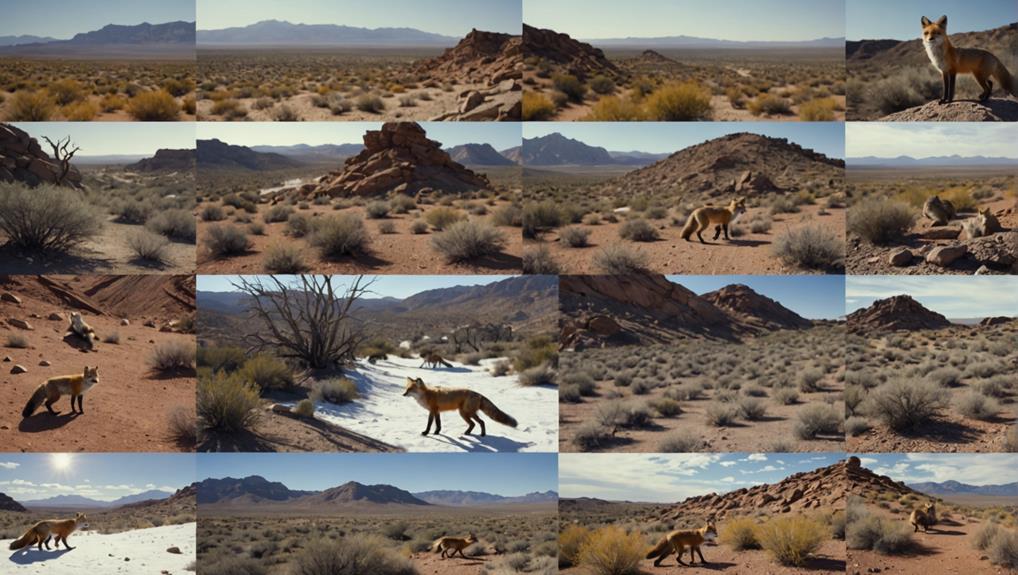
When it comes to the conservation status of fox populations, there's a lot to unpack.
While the red fox seems to be thriving, the Arctic fox is feeling the heat—literally—thanks to climate change and habitat loss.
It's important that we grasp the threats they face and the global efforts underway to protect these clever critters, because let's face it, a world without foxes would be a little less fun!
Threats to Fox Populations
Fox populations around the world face numerous threats that jeopardize their survival and conservation status. You might be surprised to learn just how many challenges these clever creatures encounter. Here are four of the most pressing threats:
- Nonnative red foxes: Their introduction in North America creates competition with native species, messing with the delicate balance of predator-prey dynamics.
- Urbanization: As cities expand, foxes lose their homes. This habitat loss leads to conflicts with humans and decreases the number of safe living environments.
- Disease impacts: Diseases like canine distemper virus (CDV) and sarcoptic mange can wipe out entire populations, making it hard for them to bounce back.
- Economic effects: In Australia, red foxes cost the agricultural sector around $227.5 million annually due to livestock predation, showing their invasive impact.
These challenges highlight the importance of conservation efforts.
By working together to protect habitats and foster wildlife coexistence, we can help guarantee fox populations thrive.
It's a tough world out there, but with your support, we can make a difference!
Conservation Efforts Worldwide
Despite the numerous threats outlined earlier, various conservation efforts are underway globally to safeguard fox populations and their habitats. You might be surprised to learn that the red fox is doing quite well in some areas, while in others, it faces serious challenges.
For instance, in Australia, introduced populations have wreaked havoc on local wildlife. That's why habitat protection is so essential!
Conservationists are focusing on strategies that promote coexistence between foxes and humans, especially in agricultural and urban settings. These efforts help reduce conflicts, allowing foxes to thrive while preserving our ecosystems.
One innovative approach includes non-lethal coyote controls on Bald Head Island, which highlights the importance of understanding the roles of different canids, including our charming fox friends.
Ongoing research into diseases like sarcoptic mange and canine distemper virus shows just how significant it's to monitor fox health. By staying informed and supporting these conservation efforts, you can play a part in protecting these incredible species.
Role of Foxes in Ecosystems
In every ecosystem where they thrive, foxes play an important role in maintaining balance. You mightn't realize it, but these clever creatures contribute considerably to the health of their habitats.
Here's how foxes make a difference:
- Controlling Prey Populations: By hunting small mammals, foxes help prevent overgrazing, making certain that plant life flourishes.
- Seed Dispersal: As omnivores, red foxes spread seeds through their scat, boosting biodiversity in their environments.
- Maintaining Predator-Prey Dynamics: Their presence keeps various species in check, supporting a rich tapestry of life.
- Enhancing Soil Fertility: Fox earths enrich soil, as their waste improves pH and nutrients, promoting lush plant growth.
Foxes adapt well to different habitats, even urban areas, which helps maintain their crucial roles despite changes around them.
So, the next time you spot a fox, remember it's not just a cute face; it's an important player in the ecosystem. By helping maintain balance and biodiversity, these furry friends guarantee that nature continues to thrive, creating a vibrant world for us all.
How cool is that?
Human Impact on Fox Habitats
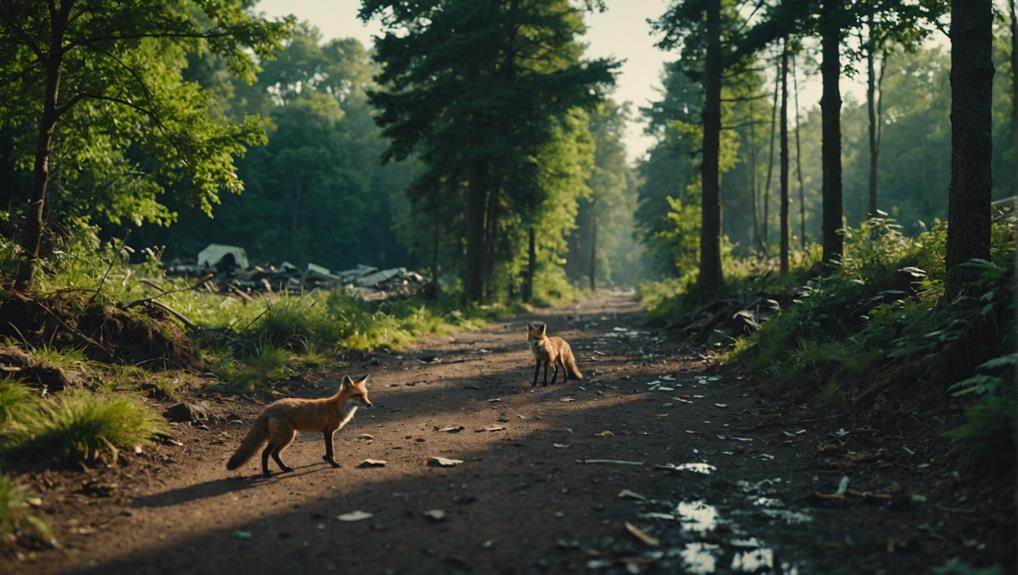
Human activities have considerably altered fox habitats around the globe, with urbanization being a primary driver of change. As cities expand, foxes adapt in surprising ways. You might find them making dens in gardens, under sheds, or even in occupied buildings! This flexibility shows just how resourceful these clever creatures can be when faced with habitat loss.
However, not all changes benefit foxes. The introduction of non-native European red foxes in North America has created fierce competition with native species. This rivalry can disrupt local ecosystems and lead to declines in indigenous wildlife.
Meanwhile, agricultural expansion and urban development continue to chip away at natural habitats, forcing rural foxes to navigate a shrinking landscape while urban foxes feast on human leftovers.
In Australia, red foxes were brought in for hunting, but this decision backfired spectacularly. The invasive species contributed to the disappearance of local wildlife, highlighting how our choices can have lasting impacts.
As you can see, the balance between humans and foxes is delicate. By understanding these challenges, you can help support efforts to protect their habitats and promote coexistence. After all, we all share this planet, don't we?
Climate Influence on Fox Distribution
As foxes adapt to the pressures of habitat loss and urban encroachment, climate change also plays a significant role in shaping their distribution. The red fox, known for its remarkable adaptability, is making its way into new territories, including the Arctic. This shift affects not just their own population but also the native Arctic foxes.
Here's how climate change influences their habitats:
- Wider Range: Red foxes thrive in various climates, from temperate forests to bustling urban areas.
- Seasonal Changes: Temperature variations and food availability can alter their foraging behavior and where they choose to live.
- Urban Settings: With human density increasing, red foxes are often found in gardens, making clever use of these spaces for denning.
- Demographic Fluctuations: Warmer weather can boost prey availability, leading to healthier fox populations.
The adaptability of red foxes is nothing short of impressive, showing that they can navigate challenges thrown by climate change.
Urban Vs. Rural Fox Habitats
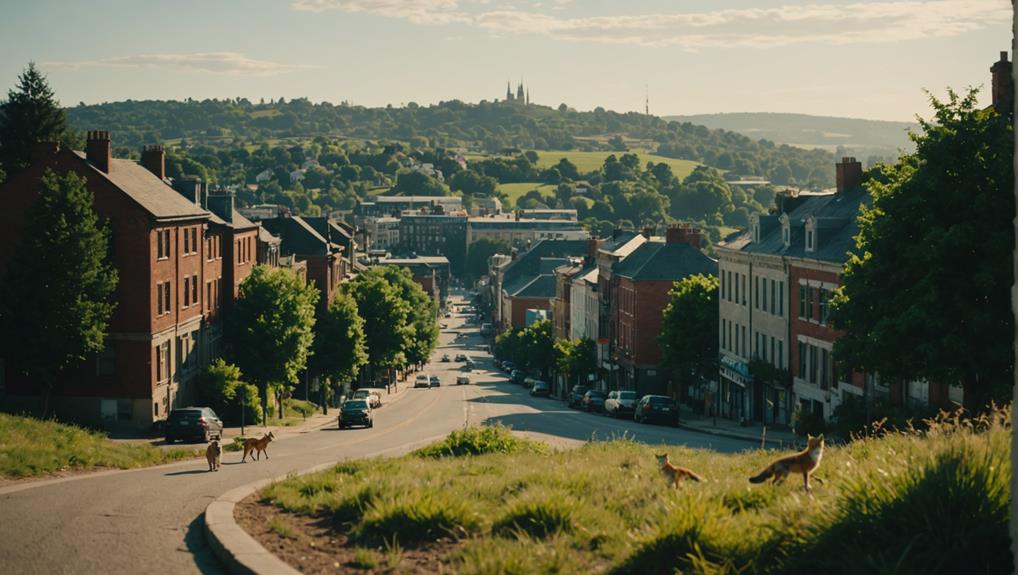
Let's take a moment to explore how urban and rural foxes live differently.
In cities, these clever critters have turned gardens and sheds into cozy homes, while their rural cousins stick to traditional burrows in the wild.
You might be surprised to learn that urban foxes munch on a mix of takeout leftovers and small animals, making their dining options a bit more varied than those of their countryside relatives.
Den Location Preferences
While urban foxes adapt to human environments by choosing less selective den sites, rural foxes maintain a preference for natural areas that offer more seclusion.
You might be surprised at how these clever creatures make their homes, depending on where they live. Here's a quick look at their den site choices:
- Urban Foxes: They often use gardens, under sheds, or even buildings. Talk about making the most of what's available!
- Rural Foxes: These foxes are more picky, favoring locations like southeast-facing slopes in natural settings. They know how to pick the perfect spot.
- Adaptability: Urban foxes thrive in human-dominated landscapes, showing that they can share and frequently use the same den sites due to limited options.
- Nursing vs. Resting: Rural foxes designate specific earths for nursing while using smaller ones for resting, keeping their family safe and cozy.
Both urban and rural foxes show amazing adaptability in their habitats.
Weather patterns don't seem to faze them either; they're consistent in their resting and denning behaviors.
Isn't it fascinating how these clever animals find a way to thrive, no matter where they are?
Foraging Behavior Differences
Foraging behavior in urban and rural foxes reveals striking differences shaped by their environments.
Urban foxes, for instance, have a unique twist to their dining habits. They show remarkable dietary flexibility, munching on about 50% meat and 50% household refuse. Yep, you heard that right! They're scavenging from our trash cans while rural foxes stick to a more traditional diet made up of around 95% small mammals and birds.
In cities, red foxes often take advantage of the abundant human food sources, adapting their hunting patterns to include a scavenger's delight. Meanwhile, rural foxes rely heavily on natural prey, like rodents and rabbits, maintaining their age-old hunting techniques.
Streetlights and the buzz of human activity in urban areas can actually turn nighttime into a buffet for urban foxes, while their rural pals face more natural predators and threats.
Seasonal changes also play a role; urban foxes often rely on scavenging during colder months when their natural prey is scarce.
All in all, these foraging behaviors highlight how adaptable and clever these furry creatures are, whether they're in a bustling city or a quiet countryside.
Future of Fox Conservation Efforts
As urbanization continues to encroach on natural habitats, the future of fox conservation efforts hinges on innovative strategies that address both ecological needs and human concerns.
To support thriving fox populations, we must focus on key areas that promote coexistence in urban environments. Here are four essential strategies:
- Habitat Protection: Safeguarding green spaces in cities helps provide safe havens for foxes, guaranteeing they've access to food and shelter.
- Community Engagement: Involving locals through backyard wildlife programs educates everyone on why foxes matter and how to live alongside them without conflict.
- Health Monitoring: Keeping an eye on diseases like sarcoptic mange allows us to implement timely interventions, helping foxes stay healthy and resilient.
- Collaborative Conservation: Working together with local authorities, conservation organizations, and researchers guarantees we're all on the same page, addressing challenges posed by urbanization.
Final Thoughts
In the grand scheme of things, foxes play an essential role in our ecosystems, and it's our job to guarantee their habitats thrive. As we've seen, these clever creatures adapt beautifully to diverse environments, but they face some tough challenges too. By getting involved in conservation efforts and being mindful of our impact, we can help keep their tails wagging. So let's not let the grass grow under our feet—every little bit counts when it comes to protecting our furry friends!

